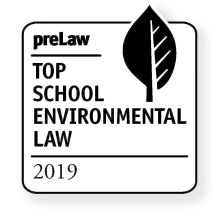
Growing strength in environmental law
UB School of Law’s strength in a critical practice area, environmental law, has received new recognition by the pre-eminent magazine for prospective law students.
PreLaw magazine, in its Winter 2019 issue due out in print and online at the end of January, named UB School of Law to its list of Top Schools for Environmental Law.
Mike Stetz, managing editor of the magazine, says the rankings are based on the breadth of each school’s offerings in the topic area. Such program offerings as a concentration in environmental law figure into the ranking, as well as beyond-the-classroom opportunities such as externships, student groups and the presence of an environmental law journal.
With a letter grade of A, the ranking puts UB School of Law in the top 20 percent of U.S. law schools for its environmental law program.
The recognition comes at a time when environmental law and policy is an increasingly important area of legal practice, and the law school’s concentration of faculty, research, clinics and programs in this area has never been stronger.
Tenured faculty members including Professors Irus Braverman, Kim Diana Connolly, Errol Meidinger, and Jessica Owley – bring specific expertise to the program in areas such as wetlands law, international trade and governance, natural resources law and land use law. Their teaching is supplemented by adjunct professors working on a daily basis in the field.
Owley directs the school’s Environmental Law Program, which offers specialized coursework for students seeking J.D. or LL.M. degrees. An important requirement is completion of a major research project. The program also helps students develop practice-ready skills through practical experience in clinical or practicum courses, and through externships in law firms, government agencies or non-profits.
The program’s core survey courses are supplemented by an evolving list of elective courses, covering issues as wide-ranging as historic preservation law, regional economic development and biodiversity.
Student-led opportunities abound including the active Buffalo Environmental Law Society and the student-edited Buffalo Environmental Law Journal. There are also opportunities for building advocacy skills, including teams that the law school sends to the Jeffrey G. Miller Pace National Environmental Law Moot Court Competition.
The Environmental Advocacy Clinic is an attractive option for many students offering exposure to diverse and sophisticated practice while working closely with supervising attorneys. “Student attorneys in the Environmental Advocacy Clinic serve as lead attorneys on important legal and policy matters,” says Connolly, the clinical director. “The clinic works on everything from international matters (such as designating the Niagara River Corridor as a wetland of international importance) to local environmental justice issues like equity in water pricing in the City of Buffalo. Student attorneys learn not just by doing, but by taking the lead in meetings, drafting filings, and contacting federal and international decisionmakers.”

Eyewitnesses at the UN
10 law students recently had the opportunity to witness firsthand critical negotiations on environmental issues in Katowice, Poland, at the United Nations Framework Convention on Climate Change – COP24 for short. This is the fourth time that Professor Jessica Owley, a specialist in environmental law, has traveled with our law students to be a part of the two-week negotiations.
